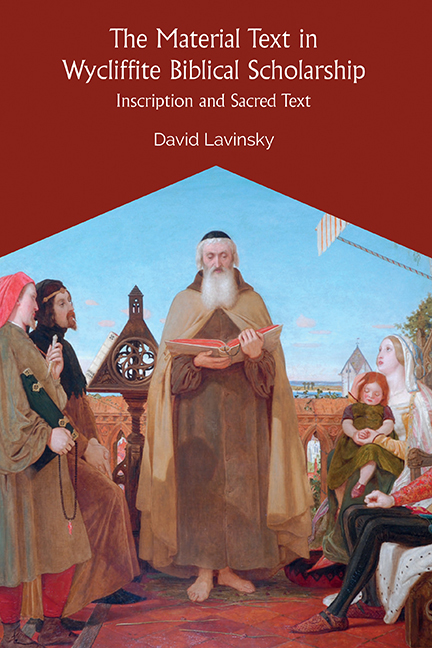Book contents
- Frontmatter
- Dedication
- Contents
- List of Illustrations
- Acknowledgements
- Abbreviations
- Introduction
- 1 “De Pellibus Bestiarum”: Scripture, Realism, and Material Form
- 2 “Stories of þe elde testament”: Adherence, Supersession, and the “Proces” of Reading
- 3 “We speke not of enke and parchemyn”: Voice, Form, and Textual Supplement
- 4 Rolle's “blessyd boke”: Heresy, Interpolation, and the Material Text
- 5 The “sentence of olde holy doctouris”: Gospel Commentary and the Materialities of the Literal Sense
- Conclusion
- Select Bibliography
- Index
- Frontmatter
- Dedication
- Contents
- List of Illustrations
- Acknowledgements
- Abbreviations
- Introduction
- 1 “De Pellibus Bestiarum”: Scripture, Realism, and Material Form
- 2 “Stories of þe elde testament”: Adherence, Supersession, and the “Proces” of Reading
- 3 “We speke not of enke and parchemyn”: Voice, Form, and Textual Supplement
- 4 Rolle's “blessyd boke”: Heresy, Interpolation, and the Material Text
- 5 The “sentence of olde holy doctouris”: Gospel Commentary and the Materialities of the Literal Sense
- Conclusion
- Select Bibliography
- Index
Summary
The Material Text in Wycliffite Biblical Scholarship examines the biblical scholarship of John Wyclif and his successors, treated here in material dating from approximately 1380 to 1420. Like so many other academic projects on late medieval writing and religious culture, this one is profoundly indebted to Anne Hudson's account of Wycliffism's history and textual oeuvre. Despite the growth of interest in Wycliffism following publication of The Premature Reformation in 1988, however, the archive there designated as “Lollard biblical scholarship” – a broad category encompassing works such as the Wycliffite Bible and Prologue, sermon collections, interpolated versions of the Psalms, glossed commentaries on the gospels, compendia of hermeneutic terms and concepts, and polemical religious writings from later stages of the movement – has gained prominence in medieval studies only recently. There is the obvious fact that for many years key Wycliffite texts remained unedited or limited to incomplete collations. Such work also has a marginal relation to Middle English literature as currently surveyed and anthologized, though this too is changing as scholars explore how writers reframed or otherwise adapted Wycliffite terms, concepts, and forms in the process of cultivating their own diverse literary vernaculars. But this evolving critical orientation must also contend with a strong impulse towards homogeneity and transhistorical coherence in the study of medieval religious movements. Variations in the development and transmission of reformist thought are sometimes difficult to discern in the case of Wycliffism given its attitudes towards scriptural authority and post-biblical revelation. Unlike contemporaries of his who sought to embed biblical scholarship in the history and tradition of the church, or to preserve the important truths which reason by itself may “fynde, leerne, and knowe,” in Reginald Pecock's words, Wyclif afforded scripture the anteriority of a divine archetype or idea. The receptivity such a “text” demands of its readers was reflected in terminology emphasizing scripture's overall unity and authority of meaning, most especially in what Wyclif referred to as the liber vitae, with everything this figure implied about retrieving the sacred sense from the material flux of written artifacts.
- Type
- Chapter
- Information
- The Material Text in Wycliffite Biblical ScholarshipInscription and Sacred Truth, pp. 1 - 22Publisher: Boydell & BrewerPrint publication year: 2017

